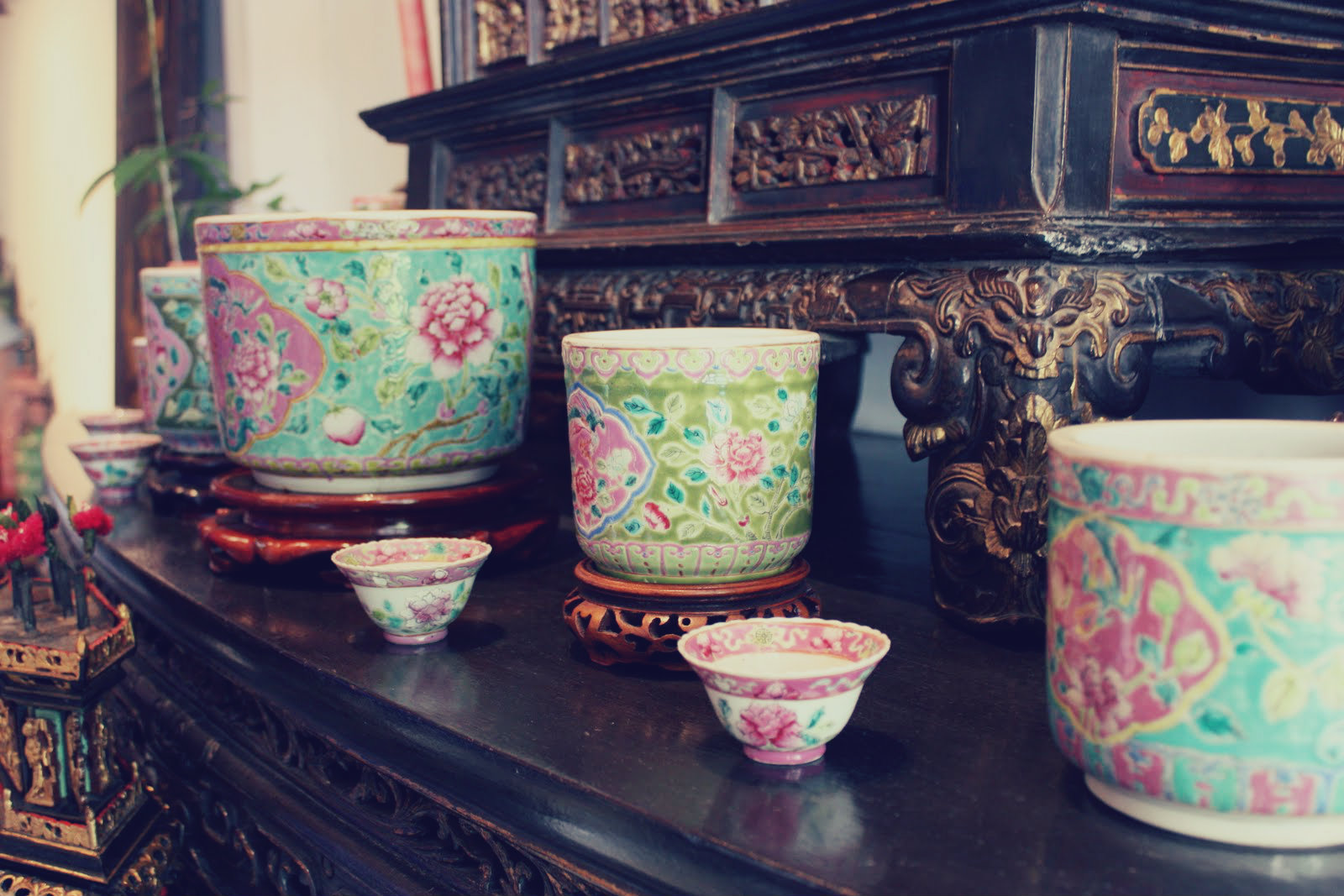海峡華人珠宝博物馆ほど、“眼福”という言葉が似合う場所も少ない。15世紀初頭、マラッカは外国語が飛び交う国際交易都市だった。約600年前、中国明代の武将、鄭和がマラッカへ航海し、当初マラッカ海峡に建国されたばかりのマラッカ王国をインド洋渡航のための根拠地として重視し、マラッカ国王と関係を築いた。マラッカ王国は鄭和艦隊の保護下で成長し、中国艦隊の来航が途絶えた後も中国の商人の行き来が絶えず、東西貿易の中継港として繁栄した。そのような商人たちの子孫であるマラッカに住む華人達の宝飾品を展示している場所が海峡華人珠宝博物馆である。ネックレスやブレスレット、靴、陶磁器、指輪など、インド、スリランカ、中国などの職人が精製した宝飾品や手芸品が数百件展示されている。
華麗な展示品を前にして、私は金と銀の光景に圧倒されながらもそれら品々をじっくりと観覧した。マラッカの華人たちが大切にしてきた、中国南部の伝統を思わせる赤みがかった金の装飾品のきらめき。透明であったり不透明であったりする、色とりどりのガラス細工。満開の桜や鳥の絵が内部にはめ込まれた、精巧そのものの真珠母。江西省や広東省へ特製品として発注し輸入した陶磁器。中国で縁起がいいとされる「牡丹」「鳳凰」などの柄が、桃色・青色・薄緑色などマラッカ特有の淡いパステル色で彩られた食器。茶器で有名な南部の景徳鎮市で、マラッカ専用に焼いてもらっていたこともあるらしい。
 再也没有比海峡华人珠宝博物馆更适合 “眼福” 这个词的地方了。六百多年前,明朝时期的郑和航行到马六甲。视当时在马六甲海峡刚建国的马六甲王国为驶向印度洋的基地,招抚了马六甲国王。因此马六甲王国在郑和舰队的保护下成长起来,中国舰队停航以后中国商人仍来来往往。王国作为东西方贸易中继港达到了繁荣的顶峰。这样的中国商人在马六甲的子孙后代们拥有的珠宝在海峡华人珠宝博物馆展示。精细的项链、手镯、鞋、瓷器、戒指等等,都是受中国的设计花样影响,由中国、印度以及斯里兰卡等地的工匠们精心打造的。珠宝馆里展示着数百件珠宝首饰和工艺品。
再也没有比海峡华人珠宝博物馆更适合 “眼福” 这个词的地方了。六百多年前,明朝时期的郑和航行到马六甲。视当时在马六甲海峡刚建国的马六甲王国为驶向印度洋的基地,招抚了马六甲国王。因此马六甲王国在郑和舰队的保护下成长起来,中国舰队停航以后中国商人仍来来往往。王国作为东西方贸易中继港达到了繁荣的顶峰。这样的中国商人在马六甲的子孙后代们拥有的珠宝在海峡华人珠宝博物馆展示。精细的项链、手镯、鞋、瓷器、戒指等等,都是受中国的设计花样影响,由中国、印度以及斯里兰卡等地的工匠们精心打造的。珠宝馆里展示着数百件珠宝首饰和工艺品。
我在金银灿烂,绚丽华贵的展品面前带着点感动凝神细看。马六甲的华人最喜欢的是中国南部传统风格的带红色的金首饰,镂空或不镂空的各种玻璃雕件。有盛开的樱花或鸟的图样的镙钿。向江西或广东特别定制的瓷器。中国吉祥物的“牡丹 “和”凤凰“图案的,桃红色,蓝色,淡绿色等马六甲流行的淡淡的柔和的色彩的餐具。中国有名的瓷器产地景德镇专门为马六甲所烧制的瓷器也有展出。
The Strait Chinese Jewellery Museum is a pure delight to the eye. During the Ming Dynasty, Zheng He, a seafaring eunuch explorer employed by the Emperor’s Court, travelled to African and Arabian Peninsulas with ships packed with Chinese porcelains, He founded stockades along the shipping lanes of Southeast Asia, one of which was based in Malacca. In the 15th century, Malacca was the midway point on the maritime crossing between China and the lands along the western rim of the Indian Ocean. Sailors from Zheng He’s fleets built homes and storehouses on the Straits of Malacca; many settled there permanently, with only one-tenth of the crew members returning to their homeland, and their descendants living in Malacca became known as the Strait Chinese. The Museum contains beautifully crafted jewellery, along with ornately decorated costumes popularly worn by the Straits Chinese, giving a glimpse of the days when their culture had blossomed at its zenith.
The craftsmanship was superb – an intricate and intimate collection of items, with gold smith tools, opium bongs, altars, wedding accessories, jewellery, anklet, earrings, clothing, desks, and sofas, tastefully and elegantly displayed. Particularly exquisite were mother-of-pearls with pictures of cherry blossoms and birds fitted inside the pearl, and porcelain dinnerware with peonies and phoenixes drawn on them in light pastel shades of pink, blue, and green, colors that are a feature of Malaccan art. Many of the items were custom made and imported for Malaccans from Southern China, known for its porcelain craftsmanship.[/vc_column_text][/vc_column][/vc
